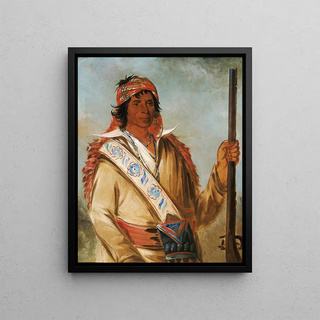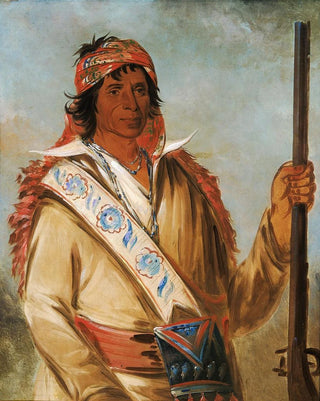Art print | Steeh-Tcha-K-Me-Co The Great King described Ben Perryman as a chief - George Catlin


View from behind

Frame (optional)
In the rich and complex universe of American art, the art print "Steeh-Tcha-K-Me-Co The Great King qualified Ben Perryman as a chief" by George Catlin emerges as a fascinating testament to the encounter between two cultures. This art print, although it cannot capture the authenticity of the original, vividly evokes the spirit of the era, transporting us to the heart of the Great Plains and Native American traditions. Catlin, as an artist and ethnographer, was able to immortalize crucial moments in the history of indigenous peoples, and this work is a perfect example. It invites us to explore not only aesthetic beauty but also the historical depth of its subjects.
Style and uniqueness of the work
George Catlin's style is distinguished by a blend of realism and romanticism. In "Steeh-Tcha-K-Me-Co The Great King qualified Ben Perryman as a chief," the artist uses vivid colors and dynamic compositions to bring his characters to life. Every detail, from traditional ornaments to facial expressions, is carefully rendered, revealing an intimacy and dignity that transcend a simple portrait. The work is characterized by a balance between respect for Native American traditions and artistic innovation, demonstrating Catlin's ability to navigate between two worlds. This painting does not merely depict a chief; it tells a story, that of a people seeking recognition and identity amid upheavals.
The artist and his influence
George Catlin, born in 1796, dedicated much of his life to documenting Native American cultures through painting. His commitment to preserving these traditions and his desire to share their beauty with the Western world make him an iconic figure in the history of American art. Catlin traveled across the continent, meeting various tribes and striving to capture their essence. His work not only influenced his contemporaries but continues to inspire generations of artists and historians. By placing indigenous peoples at the center of his work, he contributed to a better understanding of their

Matte finish

View from behind

Frame (optional)
In the rich and complex universe of American art, the art print "Steeh-Tcha-K-Me-Co The Great King qualified Ben Perryman as a chief" by George Catlin emerges as a fascinating testament to the encounter between two cultures. This art print, although it cannot capture the authenticity of the original, vividly evokes the spirit of the era, transporting us to the heart of the Great Plains and Native American traditions. Catlin, as an artist and ethnographer, was able to immortalize crucial moments in the history of indigenous peoples, and this work is a perfect example. It invites us to explore not only aesthetic beauty but also the historical depth of its subjects.
Style and uniqueness of the work
George Catlin's style is distinguished by a blend of realism and romanticism. In "Steeh-Tcha-K-Me-Co The Great King qualified Ben Perryman as a chief," the artist uses vivid colors and dynamic compositions to bring his characters to life. Every detail, from traditional ornaments to facial expressions, is carefully rendered, revealing an intimacy and dignity that transcend a simple portrait. The work is characterized by a balance between respect for Native American traditions and artistic innovation, demonstrating Catlin's ability to navigate between two worlds. This painting does not merely depict a chief; it tells a story, that of a people seeking recognition and identity amid upheavals.
The artist and his influence
George Catlin, born in 1796, dedicated much of his life to documenting Native American cultures through painting. His commitment to preserving these traditions and his desire to share their beauty with the Western world make him an iconic figure in the history of American art. Catlin traveled across the continent, meeting various tribes and striving to capture their essence. His work not only influenced his contemporaries but continues to inspire generations of artists and historians. By placing indigenous peoples at the center of his work, he contributed to a better understanding of their






